Conquest: Frontier Wars Updated Preview
This real-time strategy is almost finished, and we've got impressions from the latest build.
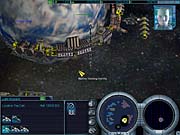
During its protracted development, Conquest: Frontier Wars has often seemed lost in space. This futuristic real-time strategy game officially began life at Digital Anvil, the design studio founded by Chris Roberts of Wing Commander fame. Best known for its space sim games, such as StarLancer and the upcoming Freelancer, Digital Anvil was preparing to venture into RTS territory with Conquest when publisher Microsoft pulled the plug on the project and purchased Digital Anvil. Conquest seemingly entered game design limbo before news surfaced recently that the project had actually been near completion months ago and would be published after all. Eric Peterson, the game's producer and designer, founded Fever Pitch Studios to finish the game and inked a publishing deal with Ubi Soft. This tortuous path to completion, which has lasted three or four years now, looks like it should work in Conquest's favor, since the developers gained extra time to add in all the features they originally desired and then finely polished the game. Based on a late beta preview copy we received, it looks like Conquest may well have been worth the wait.
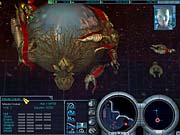
You should notice the extra polish right off. The game opens with a slick CGI movie that dramatically pulls you into the game. An imposing Terran Navy vessel, the Andromeda, slips out of a wormhole into the distant Tau Ceti system. Before researchers can begin examining the area, unidentifiable blips appear on the ship's scanners. Alien ships suddenly begin closing on the Andromeda with unbelievable speed. The Terrans have just stumbled into an alien civil war, and Earth's first casualty is the Andromeda. Making matters worse, the ship that's dispatched to find her disappears in short order, too.
Conquest features three campaigns, each telling the story from the perspective of the game's three races. For familiarity, there are the Terrans, and for diversity, there are the alien Mantis and Celareon races. The insectoid Mantis, with their bulbous, organic-looking ships, rely on swarm tactics with masses of fighters. The energy-based Celareons rely on stealth, cloaking devices, and other devious tactics.
Set in deep space, Conquest was originally to be a 3D tactical space combat game, but over time, it metamorphosed into a more traditional real-time strategy game that plays out on a flat plane. You'll see much of the familiar "harvest, build, attack" RTS formula, and controls will feel familiar if you've played RTS games before. For instance, you left-click a unit to select it, you bandbox or shift-click to select multiple units, and you can then assign numbers to groups for easy access. Once you've selected your units, different default orders become available as you move a context-sensitive cursor over various objects. Select a harvester unit, for example, and then move the mouse over an ore-laden asteroid field. The mouse icon then changes to a pickax, letting you know that the field is an exploitable resource. By using menu buttons or hotkeys, you can assign escorts, establish patrols, and set aggressiveness stances for units or groups. You can plot multiple waypoints and queue build orders to reduce micromanagement. This sort of familiarity should make learning the game's basics a breeze.
Twisting the Mold
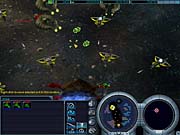
While parts of the game have clearly been formed from the standard RTS mold, Conquest will put a number of interesting twists in the old-school RTS formula. While you can travel freely across space, you can't just litter space with new buildings wherever you like. Instead, you'll build your most important structures, such as headquarters, refineries, and troop training centers, around strategically important planets. Each planet has a number of empty orbital "slots" ringing it, and each structure you build will occupy a certain number of slots. This feature should limit you from building massive, nearly impregnable bases of operations in just one place. Instead, you'll need to occupy multiple planets as you expand your empire on the way to conquest. Of course, this will require added vigilance in defending your assets, which should add excitement as you fend off multiple attacks in different areas.
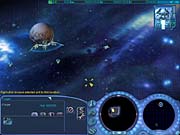
To support your forces, you'll need to harvest or manage resources in the form of ore, gas, and crew, which are required in different proportions to create and run specialized units. Happily, your resource harvester units go about their business of mining asteroid belts or refining nebular gas without needing you to follow at their heels to keep them on task. Just point a harvester at a resource and let it do its thing. As harvesters make runs from refineries to resources pockets and back again, the computer-controlled enemy will realistically try to destroy them with hit-and-run attacks. Hopefully, the AI, which can be set to multiple difficulty levels, will be that smart all around.
Countless RTS games have emphasized resource collection and unit creation as part of your overall strategy, and Conquest looks no different in that respect. Few, if any, RTS games, though, have decently incorporated the old military adage that "an army travels on its stomach." One of Conquest's most interesting features--one that should really set the game apart--is its focus on supply lines. When supplies--like missiles--run low from combat, you'll need to send your ships back to the nearest planetary supply dump for restocking. This supply line feature should add both realism and unusual tactical twists: waste all your ammo in a little skirmish far from home, and you'd better hope you don't run into a big fleet before you can restock your ships' stores.
Supply lines will be particularly important since you can play single games across up to 16 star systems at a time, the equivalent of playing a standard RTS game on a number of maps at once. To cut travel times back to your home system for new supplies, you can build supply depots in each system you visit--assuming you can capture potentially hostile planets for your use. In this respect, conquest looks like it will bear more than a passing resemblance to space-empire-building games.
To reach new systems, you travel through interstellar wormholes. There are relatively few natural obstacles on the maps, like the occasional shimmering antimatter ribbons or asteroid fields that slow ships as they cautiously navigate them. As such, the wormholes will become strategic choke points that take the place of vital bridges or mountain passes in other strategy games. By erecting jump gates around the wormholes, you can essentially lock the stellar door and bar aliens from your sector temporarily. Of course, you can expect some fierce battles over these prime pieces of celestial real estate.
Stellar Graphics
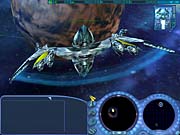
Conquest is more sophisticated than it might initially look. After all, each ship is rated for hull, shield, engine, weapons, sensors, and supply; then there are supply lines, multiple maps, multiple resources, and more to consider. Fever Pitch has taken pains to help you get into the game and manage things with ease. Each unit has a detailed status display, and pop-up explanations of various objects--like planets or stellar resource pockets--let you know exactly what each object is and how to use it. Tutorials for the game are smoothly integrated into the missions, with each new objective in the early missions introducing you to new game concepts that tie into the evolving story.
Two maps at the bottom of the screen should help you navigate through the various star systems relatively easily. The left map displays the explored areas of the system that you're currently focused on, while the right map displays other star systems as linked points. Just click on the system you want, and you jump to a direct view of it in the main window. A red warning message, coupled with a siren sound effect, warns you of problems in distant locales, so you'll be able to immediately hop to a hotspot before a remote patrol gets bushwhacked and obliterated while you're busy elsewhere.
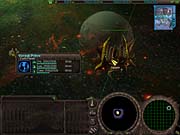
Conquest's long development time seems to have paid stylistic dividends. High production values are clear, from the opening movie and the menus to the unit animations. Menu layouts and buttons feature a unified, glossy style that makes them both easy to use and easy on the eyes. The CGI animations featured during mission briefings as in-game video transmissions from higher officers look attractive and bear the same style as those of Digital Anvil's StarLancer.
When you zoom in on individual units, you'll see all kinds of little details you might otherwise miss. Docks and factories extend spiderlike mechanical arms that nimbly assemble new ships, and damaged ships trail little puffs of smoke. Harvester ships project glowing tractor beams, and ships enter wormholes with a streak and a flash, like a Star Trek ship accelerating to warp speed. While the game is played from a top-down perspective on a flat plane, a background of glowing nebulae and constellations helps add a little sense of depth to the maps.
While Conquest's general look and feel is serious, the game knows when to lighten up, too. It has a quirky sense of humor: Mission briefings, broadcast over Terran Naval Radio and other futuristic networks, will sometimes open with satirical commercials. Expect ads for businesses with names like Implant Heaven. A Celareon commercial for a device that protects against mind probes ends with a string of rapid-fire legal disclaimers unmistakably reminiscent of a car commercial. Your Mantis superior sounds like Yoda's mean-spirited twin, warning you in fractured syntax during tutorials to "Attention pay!"
Unlike with a lot of games, it looks like Conquest's developers spent some quality time on the music. The varied score goes a long way to setting the appropriate mood, from the martial, heroic, and catchy main menu theme to minor-key pizzicato strings representing the eerie vastness of space. Just as films aren't only about visuals, neither are games, so it's nice to see developers focusing on the total presentation.
With three story-based campaigns and full-featured skirmish and multiplayer modes, it looks like Conquest: Frontier Wars should have plenty to offer. While the game might initially look like any number of other RTS games, you'll quickly see that Fever Pitch has incorporated some unusual features that give the game a distinctive pace and feel. While Conquest clearly draws on the RTS genre's past, it looks like it might well have something to offer its future.
Got a news tip or want to contact us directly? Email news@gamespot.com
Join the conversation